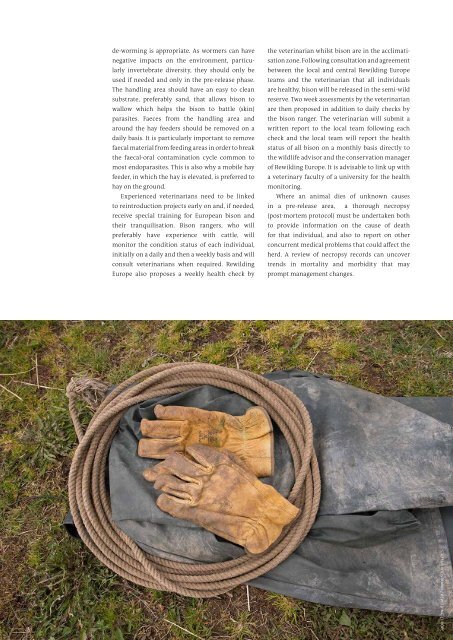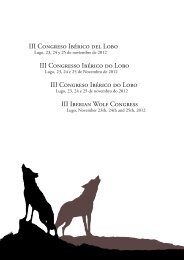de-worming is appropriate. As wormers can havenegative impacts on the environment, particularlyinvertebrate diversity, they should only beused if needed and only in the pre-release phase.The handling area should have an easy to cleansubstrate, preferably sand, that allows bison towallow which helps the bison to battle (skin)parasites. Faeces from the handling area andaround the hay feeders should be removed on adaily basis. It is particularly important to removefaecal material from feeding areas in order to breakthe faecal-oral contamination cycle common tomost endoparasites. This is also why a mobile hayfeeder, in which the hay is elevated, is preferred tohay on the ground.Experienced veterinarians need to be linkedto reintroduction projects early on and, if needed,receive special training for European bison andtheir tranquilisation. <strong>Bison</strong> rangers, who willpreferably have experience with cattle, willmonitor the condition status of each individual,initially on a daily and then a weekly basis and willconsult veterinarians when required. <strong>Rewilding</strong>Europe also proposes a weekly health check bythe veterinarian whilst bison are in the acclimatisationzone. Following consultation and agreementbetween the local and central <strong>Rewilding</strong> Europeteams and the veterinarian that all individualsare healthy, bison will be released in the semi-wildreserve. Two week assessments by the veterinarianare then proposed in addition to daily checks bythe bison ranger. The veterinarian will submit awritten report to the local team following eachcheck and the local team will report the healthstatus of all bison on a monthly basis directly tothe wildlife advisor and the conservation managerof <strong>Rewilding</strong> Europe. It is advisable to link up witha veterinary faculty of a university for the healthmonitoring.Where an animal dies of unknown causesin a pre-release area, a thorough necropsy(post-mortem protocol) must be undertaken bothto provide information on the cause of deathfor that individual, and also to report on otherconcurrent medical problems that could affect theherd. A review of necropsy records can uncovertrends in mortality and morbidity that mayprompt management changes.58STAFFAN WIDSTRAND / REWILDING EUROPE
Supplemental feeding3.4<strong>Rewilding</strong> Europe aims to prepare the Europeanbison for an independent life in the wild as muchas possible. In the pre-release phase of the re-introductionadditional food will be provided inthe acclimatisation zone as a transition fromthe previous diet to a natural diet. In generalthe animals will not be additionally fed in there-wilding zone and once released into the wild.During extreme winter conditions (snow) orextreme summer conditions (drought) additionalfeeding might be necessary if not enough naturalfood is available and the animal’s health are at risk.After release into the wild, supplemental feedingcan be used to enable animal counts to be made,individuals to be checked and as a managementtool against poaching and crop damage. However,additional feeding of bison in the wild should beavoided as much as possible.In the acclimatisation zone bison will be givenfood that resembles the diet at their place of origin,or as close to this as possible if this differs withinthe founder group. In nature, bison are intermediategrazer-browsers and their digestive systemrelies on a continuous intake of food material. Thebison should therefore be able to feed 24 hours aday. A diet of good hay/dry silage, supplementedwith commercial herbivore concentrate pelletswill provide adequate nutrition. A high fibre,low protein pellet should be selected, in consultationwith the veterinarian, but only provided innecessary quantities. Mineral imbalances shouldbe avoided and should be monitored by the veterinarian.Trace mineral and salt blocks shouldalways be available. The trace minerals should beput together based on the local circumstances inconsultation with a local veterinarian. Overfeedingand obesity may significantly reduce reproductiveability. Fruits with significant sugar content, suchas apples, can be provided to lure the animals e.g.in the handling area, but not be a regular part ofthe diet as they can contribute to rumen acidosis.Hay or hay silage can be provided by localfarmers to strengthen the relationship with thelocal people and support the local economy.During acclimatisation in the pre-release phasethe diet of the bison should ideally mimic foodintake as received in the previous bison locationand during the different seasons and consist ofas much natural food as possible. The largestpercentage of the diet should contain hay and orsilage that should be harvested locally by localfarmers. Silage should resemble hay and thuscontain little water, in order to avoid diarrhea, socalled hay-silage. This means that the grass shoulddry for at least several days before being wrappedand should be from the first cut (farmers wouldgenerally use the second cut for cattle).Within the handling area, granulates, mineralsand additional food (e.g. apples in low quantities,carrots etc. depending on the season) will beprovided to enhance the diet and to habituate theanimals to the handling area in case treatmentneeds to be provided. The diet should be composedin close consultation with the wildlife advisor of<strong>Rewilding</strong> EuropeHay should be provided in special mobilehay feeders. To minimize parasite loads the hayfeeders will be moved throughout the enclosureon a regular basis and hay will be provided inquantities sufficient for approximately threedays. This also guarantees that lower rankinganimals will receive sufficient food and that allfood provided is eaten. Rotten food that is left outprovides health risks. Browsing material in theform of branches and stems of (young) preferredtrees should be provided on a daily basis, e.g. Salixspecies, poplar species, especially aspen (Populustremula), hornbeam (Carpinus betulus), birch(Betula pubescens), ash (Fraxinus excelsior), lime(Tilia cordata), hazel (Corylus avellana) etc.; thiswill also help prevent excessive browsing in theenclosure. <strong>Bison</strong> prefer horizontal lying stems tovertical stems, as generally more young brancheswill be available. <strong>Bison</strong> that are supplementaryfed generally debark around feeding sites out ofboredom. Depending on the available natural foodin the enclosure and the season; an adult bisonneeds up to of 40kg of additional food per day.In general the bison will be prepared for lifein the wild, and therefore it will be preferable forthe animals to be released at the beginning of thevegetation season so they can adapt graduallyto a life in the wild, independent from additionalfeeding.<strong>Bison</strong> are also water dependent. In the captiveenvironment, clean, drinkable water should beavailable 24 hours a day. The acclimatisation zoneand semi-wild reserve should preferably containa stream or water source with easy access to goodquality water all year round.59



